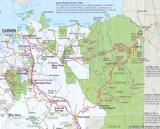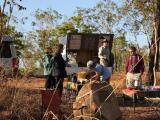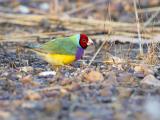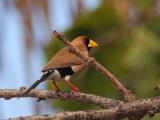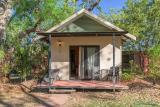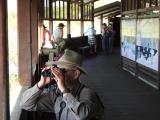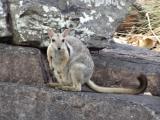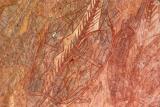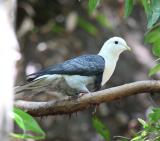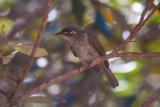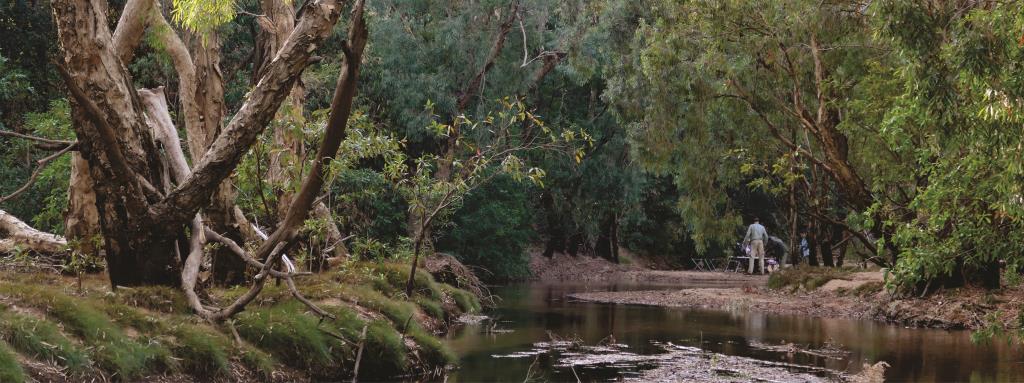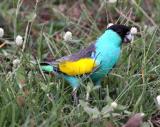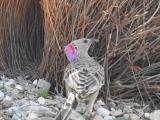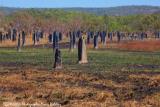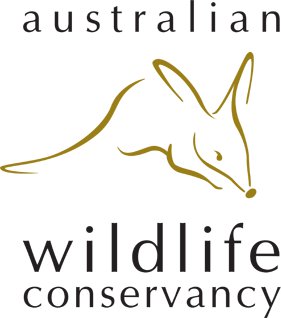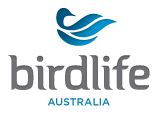Kakadu Nature's Way
Birding Darwin, Kakadu and Litchfield (Five Day)
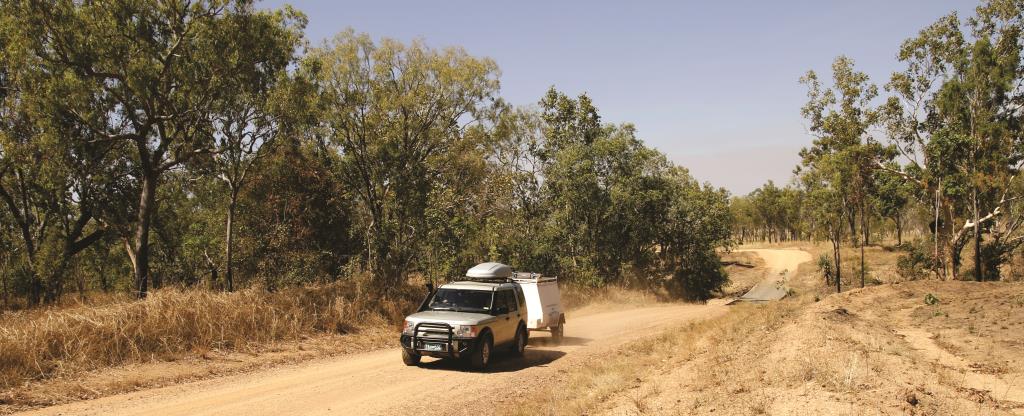
-
Five day, four night tour starting with woodland and wetland habitats in the Mary River region then through to the dramatic sandstone escarpments and wetlands of Australia's largest National Park, Kakadu. We explore open savannah country around Pine Creek then back to Darwin via Litchfield National Park. This route is called 'Nature's Way'. Total distance covered - 1200 kilometres, see map.Kakadu Natures Way route. The numbers indicate where each night is spent (photo copyright Tourism NT)
- Key species - Rainbow Pitta, Green-backed Gerygone, Broad-billed Flycatcher, Crimson Finch, Long-tailed Finch, Gouldian Finch, Hooded Parrot, Northern Rosella, Red-winged Parrot, Cockatiel, Red-tailed Black Cockatoo, Buff-sided Robin, Partridge Pigeon, Black-tailed Treecreeper and Sandstone Shrike-thrush. Red Goshawk, Black-breasted Buzzard. Also Kakadu escarpment endemics such as Chestnut-quilled Rock-pigeon, White-lined Honeyeater and Banded Fruit-dove.
- Will this tour suit me?
All accommodation is in comfortable air-conditioned rooms with ensuites. We start before dawn and stop for a bush breakfast at beautiful locations surrounded by birdlife at its busiest. Lunch is enjoyed out in the field and dinners are ala carte menus at resorts or restaurants. Groups are small, with a maximum of only six guests.
- Group Tour - $2945 per person twin share; Private Charter - $8150 (two people), additional persons from $1950 per person
- 2021 dates - July 26-30 (2 seats left)
- More information - For more information about our tours please click FAQ. To find out more about Kakadu National Park and prepare yourself for a Kakadu tour, watch and enjoy these one hour ABC documentaries Episode 1, Episode 2, Episode 3, Episode 4
"Hi Mike We just wanted to thank you once again for looking after us all so well over the past few days and for such a wonderful trip. It has been an absolute pleasure and privilege to meet you and we have thoroughly enjoyed your company and all of the great places that you have taken us to. Your knowledge of NT, the birds, Aboriginal culture etc has certainly helped to educate us in a way that we could never have achieved on our own and we will remember our fantastic bush breakfasts and lunches fondly for many years to come - huge thanks to Jenny too!!We hope that all goes well for Experience the Wild in future and we will have no hesitation in recommending you to our friends back home. Maybe we can meet up again at a future Birdfair in the UK.....Lots of love
Sue and Jim
UK October 2015
Itinerary
DAY 1 - DARWIN to MARY RIVER PARK
6.00am Pick up from Darwin accommodation
After a brief comfort stop at Corroboree Park Tavern we have a bush breakfast in savannah woodland habitat and then spend the rest of the day exploring the Adelaide River region. Our number one target is the rare and spectacularly beautiful Gouldian Finch. This area is amazingly productive for bird sightings. Species we may see in addition to Gouldian Finches are Masked, Long-tailed, Double-barred and Crimson Finches, Black-tailed Treecreeper, Varied Sitella, Diamond Dove, Channel-billed, Brush, Pallid and Little Bronze Cuckoos, Red-backed Fairy-wren, Northern Rosella, Varied Lorikeet, many raptor species including Black Falcon and Black-breasted Buzzard, as well as many of the more common species.
We have a picnic lunch on the shady banks of the Margaret River where we often get sightings of Green-backed Gerygone, Buff-sided Robin, Shining and Paperbark Flycatchers and Arafura Fantail. Mammal species in the area are Agile Wallabies, Antilopine Wallaroos and Dingoes.
Next we take the turn off to Bird Billabong in Mary River National Park, and do a 4 kilometre (return) walk through bushland and floodplain to the Bird Billabong hide, with views of Magpie Geese, Intermediate Egret, Little Egret, Great Egret, Cattle Egret, Pied Heron, White-necked Heron, Royal Spoonbill, Little Black Cormorant, Black-fronted Dotterel, Black-necked Stork and often some Johnstone's Crocodiles. THere are also many bush birds, including Rufous Whistler, Red-backed Fairy-wren, Gouldian Finch, Masked Finch, Double-barred Finch, Long-tailed Finch, Azure Kingfisher and Lemon-bellied Flyrobin.
Then we proceed to our accommodation at Mary River Wilderness Retreat, where we have the opportunity to bird along some of the wildlife tracks at the park.
We have dinner at the restaurant and compare notes on sightings for the day. After dinner we may do a night walk, looking for nocturnal resident Bush Stone-curlew, Tawny Frogmouth, Australian Owlet Nightjar and Barking Owl, snakes and nocturnal mammals.
Accommodation - Bush Bungalow at Mary River Wilderness Retreat.
DAY 2 - MARY RIVER to KAKADU
We head out early to Kakadu National Park and stop at Mamakala bird hide. We enjoy the dawn chorus while we eat breakfast, and then do the four kilometre loop walk, encountering many savannah and wetland species. Then we check out the bird hide.
We continue on to Ubirr, we explore the Manngarre Monsoon Forest walk, Cahill’s Crossing and Bardedjilidji Sandstone Escarpment walks, searching out some Kakadu escarpment endemics such as Chestnut-quilled Rock-pigeon and White-lined Honeyeater.
Other species on our target list are Partridge Pigeon, Rainbow Pitta, Shining Flycatcher, Northern Fantail, Arafura Fantail, Little Red Flying Fox and Wilkin's Rock Wallaby.
We take in some spectacular ancient rock art and a magnificent view across the Nadab Floodplain.
Dinner and bird call at the resort and some nearby nightspotting for Barking Owl.
Accommodation at Jabiru
DAY 3 - EXPLORE KAKADU
We head out early to the Burrunggui rock and Anbangbang area (Nourlangie), and after a bush breakfast at Anbangbang Billabong, we explore Burrunggui.
There is more ancient Aboriginal rock art, and more endemic species such as Banded Fruit-dove, White-lined Honeyeater, Sandstone Helmeted Friarbird and Black Wallaroo. Other species we will look for include Emerald Dove, Northern Rosella, Partridge Pigeon and Spangled Drongo.
We have a picnic lunch at Mardagul Campgrounds and then do the short Mardagul Billabong walk. Next we visit the Warradjan Cultural Centre which offers an amazing insight into local Aboriginal culture and history. There is also a well stocked cultural and natural history bookstore and authentic souvenir shop.
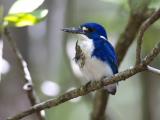
We pause on sunset and take a few minutes to absorb the splendour of the location as the sun dips below the horizon, often with hundreds of birds flying overhead to their night roosts. Then it’s the short drive to the resort to for dinner.
Dinner, accommodation and bird call at Cooinda.
DAY 4 - KAKADU to PINE CREEK
We depart before sunrise and have breakfast at a delightful location on the South Alligator River. We explore the river bed and see riparian species such as Little Shrike-thrush, Arafura Fantail and Varied Triller.
On the way to Pine Creek we visit a site where Silver-backed Butcherbirds are reliable and a very rare cycad grows.
We continue on to Pine Creek and check out some reliable areas for Hooded Parrot! Other target species here are Banded Honeyeater, Bar-breasted Honeyeater, Rufous-throated Honeyeater, Cockatiel, Red-winged Parrot, Varied Lorikeet, Great Bowerbird and Grey-crowned Babbler.
Dinner and accommodation Pine Creek

DAY 5 - PINE CREEK to DARWIN
Early bush breakfast by a river bed south of Pine Creek, where we often see Gouldian Finches, Cockatiels, Hooded Parrots, Northern Rosellas and then head north towards Darwin.
We enter Litchfield National Park, visiting and stop to view some magnificent waterfalls and the wildlife in the area. Here we may find Dingo, Short-eared Rock Wallaby, Olive Python, Merton’s Water Monitor, Spangled Drongo, Blue-winged Kookaburra, Great Bowerbird, Pheasant Coucal, Pied Butcherbird and Silver-backed Butcherbird. This is also one of the few locations where the amazing magnetic termite mounds are found.
We head back to Darwin now via the back route which takes over the beautiful Finniss River. Both Estuarine and Johnston’s Crocodiles are present here. If there is time we will expore birding hotspots around Darwin.
We have our last dinner together and review of highlights for the day and the trip.
Please Note:
The above itinerary is based on the outcomes of many previous tours to the areas described. Each season is different and as various wildlife observing opportunities arise, adjustments will be made.
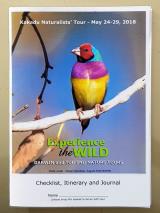
Inclusions - Four nights comfortable air-conditioned accommodation rooms with ensuites, Yellow Waters Sunset Cruise, bush breakfasts, picnic lunches and main meals, Kakadu Park entry fees. Comprehansive checklist and journal. Cold water, tea and coffee and refreshments available at all times. GST.
Exclusions - Pre and post tour accommodation, alcoholic drinks, purchases of a personal nature such as souvenirs.
Group Tour - $2945 per person twin share, single supplement $575.
Private Charter - $8150 (two people), additional persons from $1950 per person
Booking Procedure
You can book directly using our secure online booking site by clicking here. Payment options are Visa, Mastercard, Paypal or Bank Transfer. A 20% deposit secures the booking, the balance is due 30 days prior to start of tour. Please feel free to contact us if you have any queries regarding the tour.
Please Click Here to Check Availability and Book Now
Further Information - Visit our FAQ page to learn more about how our tours run. Visit our 'Darwin Accommodation' links page to find some helpful suggestions for pre and post tour arrangements. Our Terms and Conditions document outlines our cancellation and refund policy. Email enquiries@experiencethewild.com.au or ring Jenny or Mike on 0400 404 058
